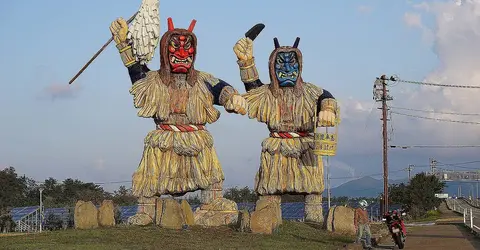Namahage 生剥
- Published on : 26/12/2018
- by : I.D.O.
- Youtube
The Japanese bogeyman
On New Year's Eve on the Oga Peninsula in Akita Prefecture. Namahage, a kind of demon, visits families and terrorizes children!
The Namahage is performed by unmarried young men who dress as demons.
The Namahage Costume
One wears a red mask - representing a male demon and the other a blue (or green) for the female monster, topped with a horsehair wig that falls over their shoulders. They are dressed in a loincloth, a cape, and leggings, all in rice straw, and wearing waraji (straw sandals). They hold a knife in the right hand and a wooden bucket in the left. Their appearance is terrifying. Masks and costumes require long hours of preparation and differ from one village to another.
Namahage Procession
In the town of Oga, where the Namahage custom originated, on New Year's Eve, these terrifying-looking young people go first to the temple and then to the village's Shinto shrine to receive the blessing from a Buddhist monk and a Shinto priest.
To read Japanese monsters and ghosts.
After warming up in front of a large wood fire in the village square, they disperse in groups of 2 or 3 and begin their visit to houses and farms. They knock on doors with gloomy "Hou-Hou" then rush into the homes yelling, "Are there any lazy children? Are there whiny and disobedient children in this house ?". But also, in the old tradition (in our timeless observed!): "Are there any daughters-in-law who don't do their job? Did they cook the beans well?" And to gesticulate, to hit their bucket of wood with their cutlass to frighten the little ones. The latter usually hide behind the family's women in the kitchen, where the demons will find them, threatening to take them with them.
The master of the house then intervenes to "protect" his offspring, replying to the devils that he has good children and does not want to give them to them. Then he regales these surprise guests with food and sake. The latter then rushes outside and knocks on the neighboring house. Meanwhile, the women of the household took care to tear off a few twigs of straw from the costume of the demons because they are supposed to bring good luck...

Statue of Namahage in Oga
z-tanuki
An ancient legend
This custom perpetuates an ancient belief in Japan: when passing from one year to another, mysterious beings, coming from afar, would appear in the villages, thus ensuring a happy and prosperous year.
Besides Namahage 's visit to the Oga Peninsula, similar events are taking place in other places in Japan. The “visitors” can come in groups of masked men dressed in strange costumes. Whatever their form, their visit is beneficial; it brings luck and comfort to the heart of winter.
The Namahage, once regaled by the master of the house, promises him that his family is blessed and that the coming year will be delighting...
See also: 5 famous Japanese legends.
The origin and meaning of the term Namahage
During the long and harsh winters of the Tohoku region, of which Akita prefecture is a part, the inhabitants warmed up around a brazier and then later, under the heat of the kotatsu (heating table under which one slides one's legs), whose projections of embers ended up causing them blisters. These peeled blisters, their flesh was "bared," which is expressed in the Akita dialect as " Namomi hagi" (raw peel). This expression comprises the word nama (live) and the verb hagi (to peel), which would have derived from Namahage, symbolizing laziness since it was the people who spent their time sitting around the brazier who had blisters. "Namomihage" is also a formula for New Year's greetings addressed to wives, children, and visitors, who are rewarded with a "Pick up your blisters"!
An event that has become touristic
This unique custom has long since become a tourist event, and the " Namahage dance " can be observed on dates other than December 31. Here are two places where you can watch this show:
- Namahage Sedo Festival
This event has been held every year since 1964 on the second Friday, Saturday, and Sunday of February at the Shinzan Shrine in Oga. After various Shinto rituals practiced at the shrine, young people masked and dressed in Namahage attire are "purified and blessed" by a priest and then presented to the public in front of a large bonfire. They then go to the mountain, where a ceremony called " taking the spirits of the Namahage " ( nyukon ) is held.
Meanwhile, a performance takes place in the Kakuraden (the building of Shinto shrines reserved for sacred dances) of Shinzan Shrine. Young people wearing different Namahage masks and costumes perform dances to the sound of taiko (Japanese drum) and imitate the gestures and cries perpetuated during visits to homes.
Discover: The costume museum
The festival ends with the procession of the Namahage descending the snow-capped mountain by torchlight and then marching around the shrine under the amazed gaze of the visitors. After receiving goma-mochi (rice cakes) grilled at stake from the Shinto priest, the day's heroes return to the mountain.
Address: Shinzan Shrine, Kitaura Shinzan aza Mizukuisawa 97, Oga City, Akita
- Oga Shinzan Densho-kan
The Oga Shinzan Folklore Museum is located in a house built in the traditional style of L-shaped farmhouses (Magariy ) of the Oga region. It offers lectures and videos on the Namahag e. Once this custom is explained, a scene of the visit of the Namahage is replayed.
Address: Kitaura Shinzan aza-Mizukuisawa 97, Akita
Address, timetable & access
Address
Timetable
JR Oga Station is 1 hr by train from JR Akita Station on the JR Oga Line.Website
http://www.namahage-oga.akita.jp/english/densyokan.html



















